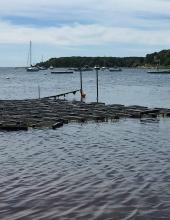
As coastal communities struggle to manage nitrogen pollution in their coastal waters, some towns are exploring the use of shellfish aquaculture to both improve water quality and support a popular oyster fishery. A two-year collaborative research project studied three popular methods for culturing oysters to quantify nitrogen removal and identify best practices for oyster growers that would maximize the water quality benefits of their oyster farms.
About this resource
This best practices guide is designed to be a resource for current and potential oyster growers that want to understand and maximize the water quality benefits of their aquaculture operations. This guide can help growers evaluate and select locations, compare growing methods, and manage their operations in a way that will lead to an overall reduction in nitrogen in coastal waters.
The details presented here stem from a two-year oyster aquaculture experiment based at Waquoit Bay Reserve in Massachusetts, but some of the information is likely to be applicable to other shellfish species and regions.
This guide is being professionally formatted; in the interim, we are providing a draft copy of the content. This page will be updated as soon as the final product is available.
Contacts
For questions about the research findings: Dan Rogers, Stonehill College, Email: [email protected]
For questions about the use and application of the guide: Tonna-Marie Surgeon-Rogers, Waquoit Bay National Estuarine Research Reserve, Email: [email protected]
Daniel Rogers, Taryn Szalay, Virginia Edgcomb, Paraskevi Mara, Chuck Martinsen, Christina Lovely, and Tonna-Marie Rogers. 2021. Best Practices Guide for Nitrogen Remediation using Oyster Aquaculture. Produced by Waquoit Bay NERR.